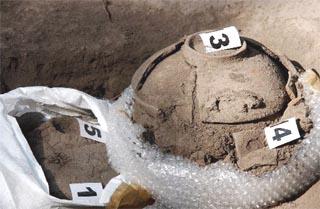January 29, 2004
Ancient settlement found near castle in Mexico City

These clay artifacts from the Teotihuacan classical period
(A.D. 600 to 300) were found behind the Chapultepec Castle.
Ancient settlement found near castle in Mexico City

These clay artifacts from the Teotihuacan classical period
(A.D. 600 to 300) were found behind the Chapultepec Castle.
Teotihuacan influence hit area earlier than thought, find suggests
Associated Press
MEXICO CITY – Archaeologists say they have discovered an ancient Teotihuacan settlement in central Mexico City, 30 miles from the pyramids where the culture flourished nearly 2,000 years ago.
The discovery of structures and tools on a hill just behind the landmark
Chapultepec Castle in December suggests the Teotihuacan culture spread
and influenced the area around Mexico City even earlier than previously
thought, archaeologists said Wednesday.
The ancient city of Teotihuacan lies north of modern Mexico City. It
remains largely a mystery, and was so even for the Aztecs, who are credited
with founding Mexico City in the 1300s.
Teotihuacan, one of the largest cities in the world around the time of Christ, had an estimated 150,000 inhabitants, and influenced art and architecture as far away as the Yucatan peninsula. However, it had been abandoned and crumbling for centuries by the time of the Aztecs.
The artifacts discovered Wednesday might push the date of Mexico City's founding back to the classic Teotihuacan period of 300-600.
Scattered settlements and relics dating to the time before the Aztecs had been found on the outskirts of modern Mexico City, but few have been found so close to the island that formed the Aztec city's center.
Relics found in the 20-square-yard excavation include six pairs of ceramic urns of Teotihuacan style. The purpose of the urns is unclear, but archeologists suspect they may have been used to hold the remains of children sacrificed to the god of rain.
The other relics found included ceramic domestic tools, a bone needle, and a figurine presumed to have been used in rituals.
In an additional 6-square-yard dig, officials uncovered remnants of a stone wall and floor dating from the same period.
"This is a very important discovery, one that is just beginning," said Maria de la Luz Moreno Cabrera, the archaeologist leading the investigation.
"It is very exciting to find such a site. ... It helps to show the real historical importance of this area."
These are the first remains to be found in Chapultepec park, which served as a retreat for rulers from Aztec kings to Emperor Maximilian.
The castle was built in 1784 as a residence for the Spanish viceroys.
Its construction likely destroyed evidence of the ancient civilization, some of which may have survived on the surrounding hillside.
The new site's excavation began when the National Historical Museum
undertook a restoration of the castle in 1998. Pre-Hispanic vestiges were
discovered beneath the castle's structure and in the surrounding hill.